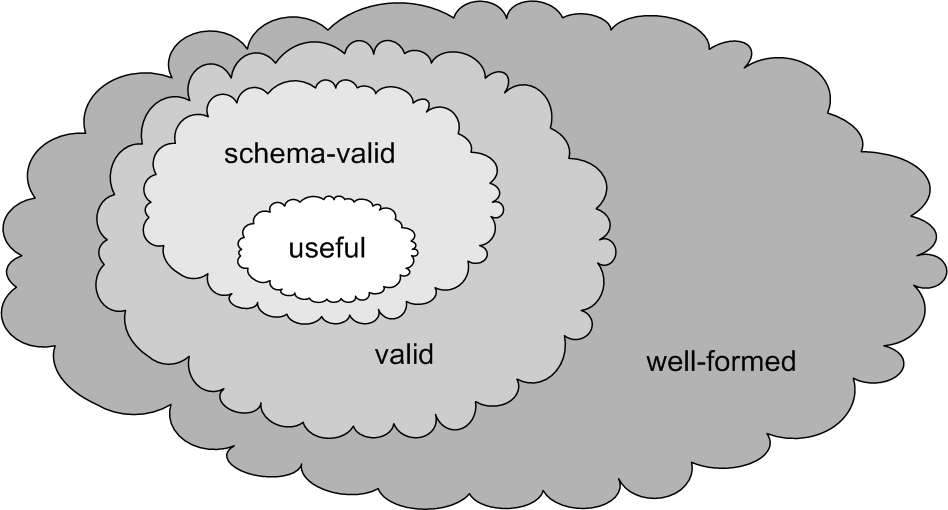XML Schema — Part I
XML Foundations (INFOSYS 242)
Erik Wilde, UC Berkeley iSchool
Tuesday, October 3, 2006
|
|
This work is licensed under a Creative Commons |
|
|
This work is licensed under a Creative Commons |
XML Schema is the most popular schema language for XML today. It has been introduced to overcome some of the commonly observed limitations of DTDs, most notably the lack of typing. Simple Types describe content which is not structured by XML markup, which means it describes attribute values and element content. Simple types can be defined by deriving new types from existing types by using type restriction. Complex Types describe element content if this content is using attributes and/or element content other than only character data. Using XML Schema's type concepts, it is easier to represent model-level information in a schema, because type hierarchies can represent model-level specializations.
XML Schema is a language for describing an XML schema.
An XML schema can be defined using XML Schema.
I would like to use XML Schema for my XML schema.
getting into people's heads

| DTD | XML Schema | |
|---|---|---|
| Concepts | some conceptual model (formal/informal) | |
| Types | ID/IDREF and (#P)CDATA | Hierarchy of Simple and Complex Types |
| Markup Constructs | Element Type Declarations <!ELEMENT order ... |
Element Definitions <xs:element name="order"> ... |
| Instances (Documents) | <order date=""> [ order content ] </order> | |
<phone>+1-510-6432253</phone>)undefined<xs:element name="home" type="phoneType"/> <xs:element name="office" type="phoneType"/> <xs:simpleType name="phoneType"> <xs:restriction base="xs:string"> <xs:maxLength value="30"/> </xs:restriction> </xs:simpleType>
<xs:element name="business">
<xs:simpleType>
<xs:restriction base="xs:string">
<xs:maxLength value="30"/>
</xs:restriction>
</xs:simpleType>
</xs:element>
by definition

anySimpleTypeminLength and maxLength)length, minLength, maxLength, pattern, enumeration, whiteSpace, maxInclusive, maxExclusive, minExclusive, minInclusive, totalDigits, fractionDigitsmaxLength)string |
length, minLength, maxLength, pattern, enumeration, whiteSpace |
|---|---|
boolean |
pattern, whiteSpace |
float |
pattern, enumeration, whiteSpace, maxInclusive, maxExclusive, minInclusive, minExclusive |
double |
pattern, enumeration, whiteSpace, maxInclusive, maxExclusive, minInclusive, minExclusive |
decimal |
totalDigits, fractionDigits, pattern, whiteSpace, enumeration, maxInclusive, maxExclusive, minInclusive, minExclusive |
duration |
pattern, enumeration, whiteSpace, maxInclusive, maxExclusive, minInclusive, minExclusive |
dateTime |
pattern, enumeration, whiteSpace, maxInclusive, maxExclusive, minInclusive, minExclusive |
time |
pattern, enumeration, whiteSpace, maxInclusive, maxExclusive, minInclusive, minExclusive |
date |
pattern, enumeration, whiteSpace, maxInclusive, maxExclusive, minInclusive, minExclusive |
gYearMonth |
pattern, enumeration, whiteSpace, maxInclusive, maxExclusive, minInclusive, minExclusive |
gYear |
pattern, enumeration, whiteSpace, maxInclusive, maxExclusive, minInclusive, minExclusive |
gMonthDay |
pattern, enumeration, whiteSpace, maxInclusive, maxExclusive, minInclusive, minExclusive |
gDay |
pattern, enumeration, whiteSpace, maxInclusive, maxExclusive, minInclusive, minExclusive |
gMonth |
pattern, enumeration, whiteSpace, maxInclusive, maxExclusive, minInclusive, minExclusive |
hexBinary |
length, minLength, maxLength, pattern, enumeration, whiteSpace |
base64Binary |
length, minLength, maxLength, pattern, enumeration, whiteSpace |
anyURI |
length, minLength, maxLength, pattern, enumeration, whiteSpace |
QName |
length, minLength, maxLength, pattern, enumeration, whiteSpace |
NOTATION |
length, minLength, maxLength, pattern, enumeration, whiteSpace |
dede-CH([a-zA-Z]{2}|[iI]-[a-zA-Z]+|[xX]-[a-zA-Z]{1,8})(-[a-zA-Z]{1,8})*
pattern, the lexical space can also be restricted| Simple Types | Complex Types | |||
|---|---|---|---|---|
| Simple Content | Complex Content | |||
| Element Only | Mixed | Empty | ||
,|#PCDATA into the content model( #PCDATA | a | b )*mixed attribute on the type marks the type as being mixed<xs:element name="p" type="mixedType"/> <xs:complexType name="mixedType" mixed="true"> <xs:choice maxOccurs="unbounded" minOccurs="0"> <xs:element ref="b"/> <xs:element name="i" type="xs:string"/> <xs:element name="u" type="xs:string"/> </xs:choice> <xs:attribute ref="class"/> </xs:complexType>
EMPTY is usedtype layerto schema languages